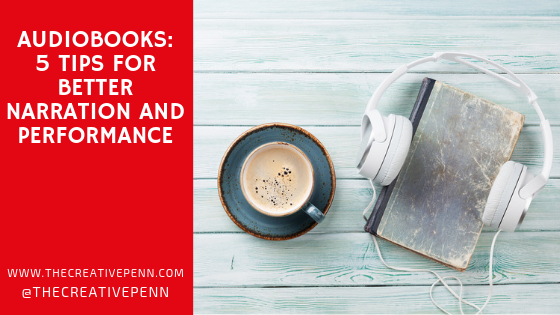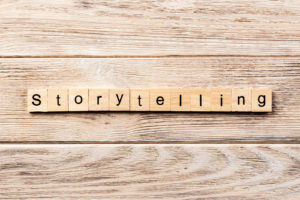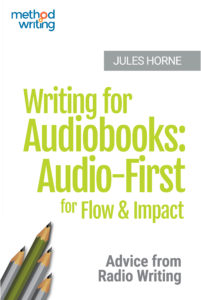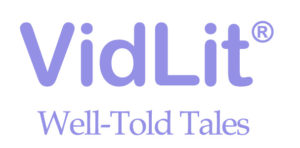Our world is fast becoming audio-first. With experience in radio, Jules Horne is perfectly positioned to share suggestions for focusing on how your book will sound once it’s narrated.
 Are you interested in publishing your books in audio form?
Are you interested in publishing your books in audio form?
With audiobooks now one of the fastest-growing markets, many writers are looking at publishing their books on audio platforms such as Audible.
But some writers are going a step further, and writing with audio performance first in mind. In other words, writing first of all to engage the ear, rather than the eye.
In many ways, this makes perfect sense. Spoken storytelling is far older than the world of reading books. And if you can write a novel that engages readers when read aloud, chances are it’s a great read, too!
So if you want to go this route, what’s different about writing for performance? Do you need to change your writing style at all?
I write fiction, but I also write audio-first, thanks to a background in broadcasting and radio drama. I’ve also written stage plays and performance poetry where spoken word techniques come first – and writers in these other worlds do think a bit differently!
So I’ve compiled some tips from audio-first writing, so you can tweak your script and get the best results for your audiobook.
1. Audio writing needs to be super-clear
Audiobook ‘readers’ are often doing something else at the same time as listening to your book, such as driving, walking, or doing the dishes. They may have a split focus.
And even if listening with full concentration, they usually just get one chance to understand your words as they fly past.
This is very different from reading a book, where people can reread, scan, jump about and even flick to the end. So you really can’t be clear enough!
I’ve seen broadcast studio managers use tiny, cheap speakers to test their recording. If it’s good enough to come through lo-fi speakers with clarity, it’s ready to face the different scenarios it’ll encounter with listeners out in the field.
What to do:
 If you’re writing non-fiction, include plenty of signpost words (“connectives”) to highlight change of flow.
If you’re writing non-fiction, include plenty of signpost words (“connectives”) to highlight change of flow.
Words and phrases such as finally, therefore, and on the other hand help to pull the reader through more easily, by drawing attention to contrast, emphasis, escalation and other changes in the underlying shape.
If you’re writing fiction, informal signal words such as then, while, so, but, and although are all the more important.
Repetition of key orientation words such as the character name are helpful, too.
2. Listeners need attunement time
It takes a few seconds for listeners to tune into new voices and changes of scene or emphasis. This might be because there’s suddenly an unfamiliar voice, or because they’ve drifted and a fresh topic has perked up their attention.
That’s why you hear radio presenters using a lot of phrases like ‘in other news’, ‘meanwhile in Scotland’, and ‘staying with domestic news…’
Opening phrases and words are important, but those very first words of fresh attack sometimes get lost, because the listener is still getting attuned.
What to do:
Try beginning new sections with the main orientation words a few words in. This is particularly helpful in fiction, where you can’t rely on section headers.
For example, ‘It was a dark and stormy night as Mike arrived at the mansion.’ Mike (protagonist) and the mansion (setting) are more important than the weather, in terms of orienting the reader securely with your story. The detail can come later.
Or, for example, if we need to know that Mike has a knife, put it near the top for orientation, but not in the first few seconds, to allow for attunement.
Don’t use this rhythm too often! You need to ring the changes or it’ll sound repetitive. Just be extra careful to plant clear opening signposts in audio.
3. Performing nouns and landing
Audio-first writing has a lot in common with oral storytelling and other spoken forms such as performance poetry. Performance writing has its own structures and tropes, including the use of repetition and rhythm.
 All writers use these to a degree, of course – the effects are just far more pronounced with the spoken word. However, not all words are equal.
All writers use these to a degree, of course – the effects are just far more pronounced with the spoken word. However, not all words are equal.
An experienced stage director I’ve worked with says the secret of performing text for clarity is to “land the nouns”. As long as the nouns are clear, the audience will get the general gist, even if they don’t get the detail.
What do to:
Take a paragraph or two of your writing and highlight the nouns. Now read aloud, speaking the nouns with crisp emphasis.
Does this tell the story clearly? Is anything muddy?
Note that ends of sentences and paragraphs are powerful positions to “land” on. Do your paragraphs have a clear, resonant ending for the narrator to land on, or do they run out of steam?
Sometimes, clipping off a clause at the end to expose a more important word can make all the difference – like pruning a plant! Again, ring the changes so that your rhythms don’t get repetitive.
4. Breathing and ‘which’ clauses
Writing for audio typically has shorter sentences than writing for the eye. That’s not surprising, as it’s led by our limited lung capacities and the natural rhythm of breathing.
If you have an expansive and wordy writing voice, it can come as a surprise when narrators struggle to read your writing.
 When I first started writing stage plays, I realised how breathless my writing was when actors with well-trained lungs ran out of steam at the ends of lines. My writing soon sharpened up.
When I first started writing stage plays, I realised how breathless my writing was when actors with well-trained lungs ran out of steam at the ends of lines. My writing soon sharpened up.
What to do:
Read your writing aloud. I do this at every stage of writing – while drafting and editing, as well as when preparing a script for a narrator.
This soon reveals sentences that are too long and meandering to read aloud well. Look out in particular for “which” clauses that qualify nouns. “Which” clauses can get very unwieldy, and sentences with long qualifiers like this often read better when they’re cut in two.
5. Audiobooks are performance scripts
You may not have conceived your book as a script for performance, but once it’s in the hands of a narrator, that’s what it essentially becomes.
For some writers, this is a mindset shift, but it can be very helpful. It tightens your writing, makes editing decisions easier, and puts audience connection right at the top of your considerations.
What’s more, it gives you license to go to town on character voices, rhythm, pace, dialect, and other sound delights – elements you probably use anyway, but which truly come into their own with the spoken word.
What to do:
 Conceive your next audiobook for performance from the start. Read it aloud while writing, to feel the rhythm and pace, and how the sentences rise and fall.
Conceive your next audiobook for performance from the start. Read it aloud while writing, to feel the rhythm and pace, and how the sentences rise and fall.
Think about the innate music of the language and whether it’s “actable”, giving good opportunities to the narrator. Check that it has plenty of variety in pace, mood, and voice for fiction.
With non-fiction, focus on great clarity and economy, and check that the viewpoint creates the right kind of audience connection for your genre and topic – authoritative, business-like, friendly? Spoken word makes more use of second person “you”, which may be relevant for your book.
BONUS TIP: What about Whispersync compatibility?
Whispersync is an Audible feature that synchronizes audiobooks with the Kindle ebook version. So when your audience switch platforms, it’s seamless and they don’t lose their place in the book.
For this to work, the audio book and Kindle versions need to be pretty well identical. Not all audiobooks are compatible with Whispersync, but with increasing convergence between book reading and listening, it’s likely publishers heavily into Amazon will want to make their new books Whispersync compatible, to help with cross-promotion.
What to do:
If you want your next book to be Whispersync-compatible, consider writing it with audio-first in mind, and ensure it works well for performance. The print and ebook can more easily be created from the audio script than the other way around.
With fiction, this should be relatively straightforward.
With non-fiction, it’ll depend on your genre and content. Images, graphs and tables are tricky, and lots of sub-headings and layout hierarchies don’t work well in audio format. Audio recordings are more time-consuming and costly to update, too.
If your book is image, table or link-heavy, you may decide not to bother with Whispersync, or you could provide a reader download for visuals, or information with a short shelf-life – a great way to connect to readers, too!
When you’re writing, do you consider how your books will sound when narrated? Please leave your thoughts below and join the conversation.

 Jules Horne is an award-winning fiction writer and playwright. She teaches for the Open University and lives in the Borderlands – the part of Britain that inspired Game of Thrones.
Jules Horne is an award-winning fiction writer and playwright. She teaches for the Open University and lives in the Borderlands – the part of Britain that inspired Game of Thrones.
For a manual of performance-ready tricks and techniques needed for audio-first writing, see Writing for Audiobook: Audio-first for Flow and Impact by Jules Horne, Book 3 in the Method Writing series.
